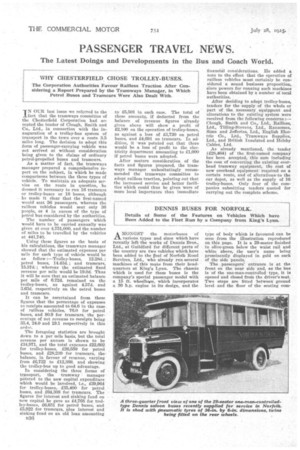PASSENGER TRAVEL AWS. '
Page 20

If you've noticed an error in this article please click here to report it so we can fix it.
The Latest Doings and Developments in the Bus and Coach World.
WHY CHESTERFIELD CHOSE TROLLEY-BUSES.
The Corporation Authorities Favour Railless Traction After Considering a Report Prepared by the Tramways Manager, in Which Petrol Buses and Tramcars Were Also Dealt With IN OUR last issue we referred to the fact that the tramways committee of the Chaterfield Corporation had accepted the tender of Clough, Smith and Co,, Ltd., in connection with the inauguration of a trolley-bus system of transport in the town over a route 3.5 miles long. The decision to adopt this form of passenger-carrying vehicle was not arrived at without consideration being given to the claims of ordinary petrol-propelled buses and tramcars.
As a matter of fact, the tramways manager prepared a comprehensive report on the subject, in which he made comparisons between the three types of vehicle. To maintain an adequate service on the route in question, he deemed it necessary to run 16 tramcars or trolley-buses or 18 buses, although he made it clear that the first-named would seat 56 passengers, whereas the railless vehicles would seat only 36 people, or 4 in excess of the type of petrol bus considered by the authorities.
The number of passengers which would have to be carried annually was given at over 4,751,000, and the number of miles to be travelled by the vehicles at 441,740.
Using these figures as the basis of his calculations, the tramways manager showed that the estimated expenses per mite for each type of vehicle would be
as follow :—Trolley-buses, 12.28d.; petrol buses, 14.43d.; and tramcars, 15.37d.; whereas the estimated fixed revenue per mile would be 19.0d. Thus it will be seen that an estimated balance per mile of 6.72d. remained on the trolley-buses, as against 4.57d. and 3.63d. respectively on the petrol buses and tramcars.
It can be ascertained from these figures that the percentage of expenses to receipts amounted to 64.6 in the case of railless vehicles, 76.0 for petrol buses, and 80.9 for tramcars, the percentage of net revenue to receipts being 35.4, 24.0 and 19.1 respectively in this
The foregoing statistics are brought down to a per mile basis, but the total revenue per annum is shown to be £34,971, and the total expenses £22,602 for trolley-buses, £26,559 for petrol buses, and £28,239 for tramcars, the balance, in favour of revenue, varying from £6,732 to £12,369, and showing the trolley-bus up to good advantage.
In considering the three forms of transport, the tramway manager pointed to the new capital expenditure which would be involved, i.e., £39,964 for trolley-buses, 135,400 for petrol buses, and £64,308 for tramcars. The figures for interest and sinking fund on new capital he gave as £4,768 for trolley-buses, £6,631 for petrol buses, and £5,922 for tramcars, plus interest and sinking fund on an old loan amounting
B36 to £5,501 in each ease. The total of these amounts, if deducted from the balance of revenue figures already given above will show a profit of £2,100 on the operation of trolley-buses, as against a loss of £3,720 on petrol buses, and £4,691 on tramcars. In addition, it was pointed out that there would be a loss of profit to the electricity department amounting to £1,000 if petrol buses were adopted.
After mature consideration of the facts and figures prepared, the tramways manager unhesitatingly recommended the tramways committee to adopt railless traction, pointing out that the increased service and better facilities which could thus be given were of more local importance than immediate
financial considerations. Ile added a note to the effect that the operation of railless vehicles must certainly be considered a sound business proposition, since powers for running such machines have been obtained by a number of local authorities.
After deciding to adopt trolley-buses, tenders for the supply of the whole or part of the necessary equippont and alterations to the existing system were received from the following concerns :— Clough, Smith and Co., Ltd., Railless, Ltd., Tilling-Stevens, Ltd., Ransomes, Sims and Jefferies, Ltd., English Electric Co., Ltd„ Tramways Supplies, Ltd., and British Insulated and Helsby Cables, Ltd.
As already mentioned, the tender (f92,464) of the first-named company has been accepted, this sum including the cost of converting the existing overhead tramway equipment, the cost of new overhead equipment required on a certain route, and of alterations to the car depot, as well as the supply of 16 trolley-buses. Only four of the companies submitting tenders quoted for carrying out the complete scheme.




























